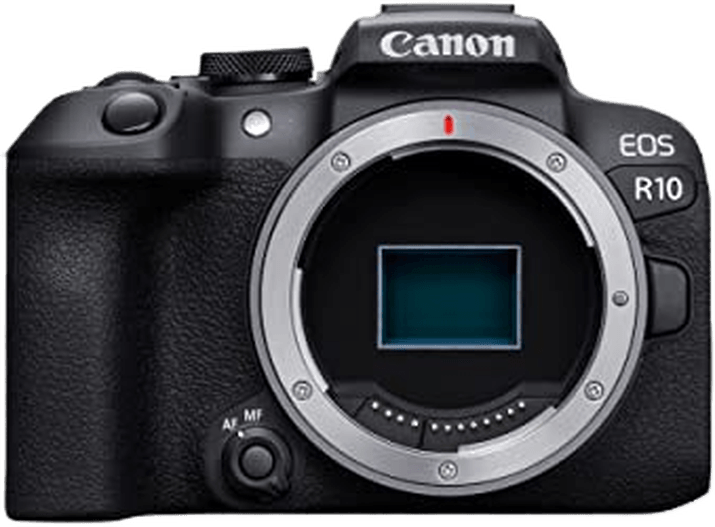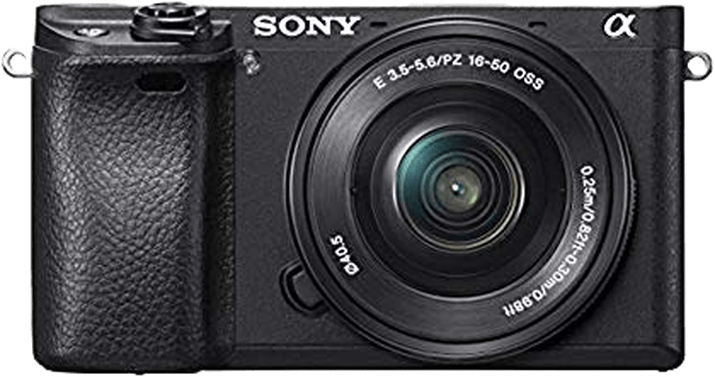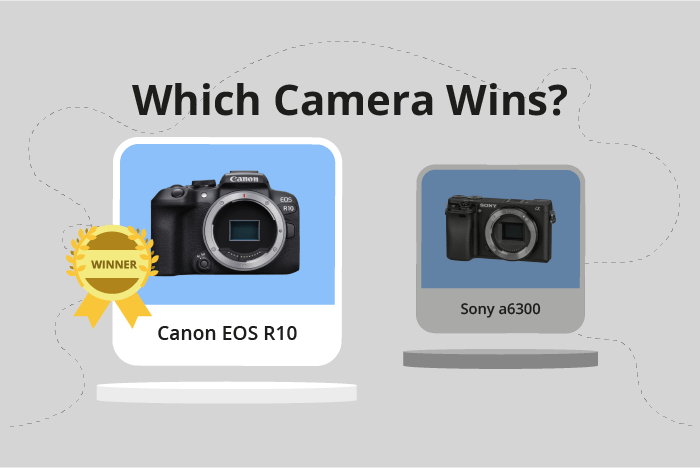Canon EOS R10 vs Sony a6300 Comparison
Canon EOS R10

Sony a6300

The Canon EOS R10 takes the lead with a score of 69/100, outperforming the Sony a6300, which scored 61/100. Both mirrorless cameras share similarities in their general specifications, including their camera type and weight, with the Canon EOS R10 weighing 426g and the Sony a6300 weighing 404g.
The Canon EOS R10 outshines the Sony a6300 with its more recent release in 2022, providing updated technology and features. Additionally, the EOS R10 offers a slightly lower launch price at $980 compared to the a6300’s $1000. However, the Sony a6300 has a more compact design, measuring 120 x 67 x 49mm, making it easier to carry and handle.
Taking these points into account, the Canon EOS R10 proves to be a better choice due to its updated technology and lower price, while the Sony a6300 may be more suitable for those prioritizing a compact design.
Canon EOS R10 vs Sony a6300 Overview and Optics
The Canon EOS R10 outperforms the Sony a6300 in optics with a score of 71/100, a 3-point difference from the Sony’s 68/100. Both cameras share similarities such as 24-megapixel resolution, CMOS sensor type, APS-C sensor size, and the lack of image stabilization.
The Canon EOS R10’s superiority in optics is evident in its faster shooting speed and higher DXOMARK sensor score. With a shooting speed of 15 frames per second, the R10 outpaces the a6300’s 11 frames per second, providing better performance for capturing fast-moving subjects. Additionally, the R10’s DXOMARK sensor score of 97 surpasses the a6300’s 85, indicating better overall image quality and low-light performance.
The Sony a6300 holds an advantage in megapixel count, albeit a small one, with 24.2 megapixels compared to the R10’s 24 megapixels. This minor difference contributes to slightly higher image resolution, benefiting photographers who require more detailed images for large prints or cropping.
Regarding lens compatibility, the Canon EOS R10 utilizes the Canon RF lens mount, while the Sony a6300 uses the Sony E lens mount. This difference in lens mounts may be a deciding factor for photographers who already own lenses compatible with either system.
Taking these factors into account, the Canon EOS R10 stands as the winner in optics, providing faster shooting speed and superior sensor performance. The Sony a6300’s marginal advantage in megapixel count and different lens mount compatibility may cater to specific user preferences or existing lens collections.
Canon EOS R10 vs Sony a6300 Video Performance
The Canon EOS R10 and Sony a6300 both have a video score of 91/100, indicating that their video capabilities are equally impressive. Both cameras share common features such as 4K maximum video resolution, 3840 x 2160 video dimensions, a maximum video frame rate of 120fps, and built-in time-lapse functionality.
The Canon EOS R10 stands out in its user-friendly design and compatibility with a wide range of Canon lenses, making it an excellent choice for those who are already invested in the Canon ecosystem. Additionally, the EOS R10 is known for its reliable autofocus system, which is essential for capturing sharp and clear videos.
On the other hand, the Sony a6300 is a compact and lightweight camera, making it a more portable option for those who need to carry their gear around frequently. Furthermore, the a6300 is often praised for its low-light performance and the ability to capture stunning videos in less-than-ideal lighting conditions.
After considering each camera’s strengths, it is evident that both the Canon EOS R10 and Sony a6300 are excellent choices for videographers. The EOS R10 is a better fit for users who prioritize a user-friendly design, lens compatibility, and reliable autofocus. In contrast, the Sony a6300 is ideal for those who value portability and low-light performance. Ultimately, the choice between these two cameras depends on the specific needs and preferences of the user.
Canon EOS R10 vs Sony a6300 Features and Benefits
The Canon EOS R10 outperforms the Sony a6300 with a feature score of 70/100 compared to the latter’s 54/100. Both cameras share some specifications, such as a 3-inch screen size, flip screen, lack of GPS, and WIFI connectivity. However, the EOS R10 surpasses the a6300 in specific areas, contributing to its higher score.
The EOS R10 boasts a touchscreen, which the a6300 lacks, allowing for more intuitive and efficient control. Additionally, the screen resolution of the R10 is 1,040,000 dots, higher than the a6300’s 921,600 dots, resulting in a clearer and crisper display. The R10 also features Bluetooth connectivity, providing more options for transferring files and remote camera control.
On the other hand, the Sony a6300 does not have any significant advantages over the EOS R10. Both cameras have a flip screen and WIFI, but the a6300 does not offer any additional features that make it stand out from the R10.
In comparing the Canon EOS R10 and the Sony a6300, the R10 clearly takes the lead in terms of features. With a higher feature score, touchscreen capabilities, better screen resolution, and Bluetooth connectivity, the R10 provides a more comprehensive and user-friendly experience. The a6300, while still a decent camera, falls short in comparison to the R10, as it does not bring any unique or superior features to the table. Consequently, the Canon EOS R10 emerges as the better choice between the two cameras.
Canon EOS R10 vs Sony a6300 Storage and Battery
The Canon EOS R10 outperforms the Sony a6300 in storage and battery, scoring 40 points compared to the a6300’s 24 points. Both cameras share some common specifications, such as a single memory card slot and compatibility with SD, SDHC, and SDXC memory cards.
The EOS R10 surpasses the a6300 with its longer battery life, capable of capturing 450 shots on a single charge, while the a6300 only manages 400 shots. Additionally, the R10 uses an LP-E17 battery type and offers USB charging, providing users with more convenient charging options.
Despite the lower score, the Sony a6300 still performs well in storage and battery aspects. It uses an NP-FW50 battery type, but it lacks USB charging, which might be a disadvantage for some users.
Considering these factors, the Canon EOS R10 proves to be the more reliable option in terms of storage and battery life, while the Sony a6300 falls short in comparison.
Canon EOS R10 vs Sony a6300 – Our Verdict
Are you still undecided about which camera is right for you? Have a look at these popular comparisons that feature the Canon EOS R10 or the Sony a6300:

